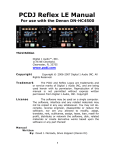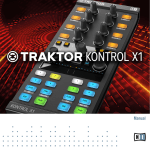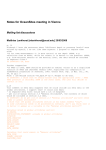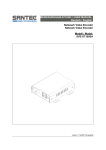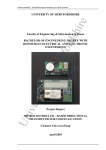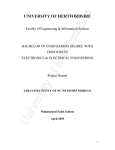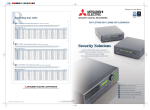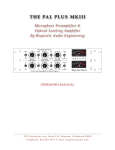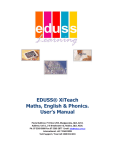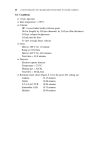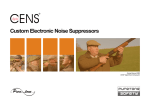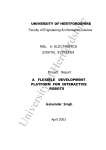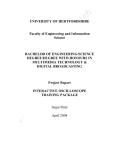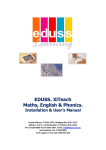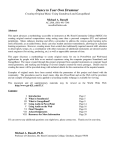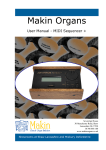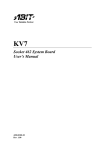Download University of Hertfordshire
Transcript
UNIVERSITY OF HERTFORDSHIRE ire Faculty of Engineering and Information Sciences dsh BACHELOR OF SCIENCE DEGREE WITH HONOURS IN MULTIMEDIA TECHNOLOGY Project Report for INTERACTIVE DJ TUTOR Un ive rsit yo fH ert David Robinson ire dsh Abstract Un ive rsit yo fH ert for This report is written to cover the various stages throughout the creation of the interactive DJ tutor software tool. It is written to encompass everything from problem analysis through design, implementation testing and conclusion. It will include a definition of the objectives and functionalities that the software package will achieve and explain how successful the project is at attaining these goals. David Robinson Page 2 04/12/2003 ire Acknowledgements dsh Throughout the creation of both the project and the report there have been certain people that without their help and guidance my progress would have never got off the ground. These are: for Scarlett Xiao, my project tutor, for providing constant guidance and assistance throughout the duration of the project, without which this achievement would not have been possible. My thanks go out to Nettwerk, Fade and Renaissance records, for either the use of records from their catalogues or general assistance. ert Appreciation and respect goes to Kenny Pierce an up and coming hard house / trance DJ for his valuable assistance in data collection and general help. Un ive rsit yo fH Thank you to everyone else that participated in my data collection exercises and testing these people include: Ian Gunn, Peter Robinson and Paul Walker. David Robinson Page 3 04/12/2003 Un ive rsit yo fH ert dsh DJ – Disc Jockey. Mixer – The DJ’s hardware for blending between two or more audio inputs. Turntable – The record deck. Record – Can be used to describe a song in any recording format. House – The style of music covered by the software. Blend – The skill of mixing two records together smoothly. Cut – The skill of mixing two records very quickly to form a natural continuation. Beatmatch – To synchronise two records perfectly. Phasing – When two records will not synchronise correctly. Bedroom DJ – A DJ who doesn’t play pofessionally for ire Glossary of Terms David Robinson Page 4 04/12/2003 Table of Contents Chapter 1 – Introduction ire page 1. Introduction …………………………………………………………………………….6 2. Report Structure……………………………………………………………………….6 3. Aims and Objectives………………………………………………………………….7 dsh Chapter 2 – Background Information 1. Other Available Teaching Aids…………………………………………………….8 2. Records Used in the production of the software……………………………9 3. DJ hardware used in the lessons………………………………………………..10 Chapter 3 – Analysis for 1. Evaluation of the problem definition……………………………………………11 2. Defining user requirements………………………………………………………..12 3. Research on learning methodologies…………………………………………..14 ert Chapter 4 – Design fH 1. Initial Storyboard Approach………………………………………………...…….15 2. The Lesson Structure…………………………………………………………….….16 a. Beginner………………………………………………………………………16 b. Intermediate………………………………………………………………..17 c. Advanced…………………………………………………………………….18 3. HCI Research…………………………………………………………………………..19 4. User exposure & Feedback………………………………………………………..20 5. Website final design………………………………………………………………….21 Chapter 5 – Implementation rsit yo 1. Overview of the implementation process…………………………………….22 2. Software Tools a. Macromedia Director b. Macromedia Fireworks c. EO Video d. Sonic Foundry Soundforge e. Adobe Photoshop f. Audiograbber g. Microsoft Frontpage…………………………………………….pp.23-25 Chapter 6 – Testing User feedback………………………………………………………………………...26 Test Methods……………………………………………………………………….…26 Test Platforms………………………………………………………………………...27 Test Results…………………………………………………………………..pp.28-29 Problems Discovered……………………………………………………………….30 Un ive 1. 2. 3. 4. 5. Chapter 7 – Conclusion 1. 2. 3. 4. Re-State Aims and Objectives………………………………………………………..31 Evaluation of achieved Aims and Objectives…………………………………….32 Problems Encountered…………………………………………………………………..34 Further Development…………………………………………………………………….35 References……………………………….……………………………….pp.36-37 Bibliography………………………………………………………………pp.38-39 Appendixes…………………………………………………………….…pp.40-44 (User Manual----pp.45-55) David Robinson Page 5 04/12/2003 ire Chapter 1 – Introduction for “There is a lot about the noble craft that must be learnt and can be taught” [1] dsh Introduction yo Report Structure fH ert The world of the professional DJ has never been as it is today, the superstar DJ has risen from humble origins as a person who simply plays someone else’s music, to a central figure in the music industry. As such, more and more people are looking to share their ideas and musical tastes with as many like minded people as possible and becoming DJ’s themselves. With turntables now outselling guitars there needs to be a serious look at what self tuition materials there are available for those hoping to learn this difficult but rewarding skill. rsit The structure of this report is straight-forward, there is a description of the problems to be solved with the software, described as a series of aims and objectives that should be complete by the end of the project time-span. At the end of the report there will be an analysis into how successful the software is at achieving all the aims set out at the start. Throughout the report, details on the following stages will be documented: Background Information (Research, Market Research) Analysis (Problem Definition, User Requirements) Design (Explaining the software design processes) Implementation (An overview of the progress with implementing the software) Testing (How the product was tested and how successfully it performed) Conclusion (Including how many aims were achieved) Un ive By the end of the report it is hoped that you will have a great understanding of how the software was researched, implemented, tested and evaluated. As well as why the subject matter was chosen. David Robinson Page 6 04/12/2003 ire Aims and Objectives To teach the student how to become a better DJ. dsh The software package will meet the following aims and objectives. for To cater for DJ’s of different Skill levels, so that the beginner isn’t thrown in at the deep end, and the more experienced DJ isn’t working through elementary lessons. ert To provide a useful multimedia experience for the student, where video and sound is used for good tuition purposes and is not present simply for aesthetic reasons. fH To provide the student with a reliable method of remote assessment. Possibly via the use of a file sharing service, where existing DJ’s can review the students progress. To provide teaching tools for the student that are not available in other teaching applications already available. yo To avoid information overload, it is expected that the student uses the software at the same time as he/she is practising the lessons, too much audio and visual stimulation can be distracting when there is so much else to think about in any one lesson. rsit To provide flexibility for the student, so that he or she doesn’t have to partake in lessons that are not important for them. Implemented through the use of a search engine to locate lessons. Un ive The project deliverables will be in the form of a CD-ROM application and a web-site linked to from the CD. David Robinson Page 7 04/12/2003 ire Chapter 2 – Background Information dsh This chapter aims to give an idea of existing teaching materials and gives an explanation of the tools and records used in the lessons. Other available Teaching Aids yo fH ert for Most of the existing teaching aids available for the aspiring DJ are in the form of books, the most popular being “How to DJ (Properly)” by Frank Broughton and Bill Brewster. Broughton and Brewster also have a regular column in MixMag magazine and are widely respected as being two of the best DJ’s in the field with an amazing knowledge and enthusiasm for dance music. This book is in use on several DJ tuition courses that are available throughout the country. Other titles in a similar vein to the above title include, “Turntable Technique: The art of the DJ” By Stephen Webber. This title is unique in that it comes complete with two records for tuition purposes. This is an intriguing idea but unfortunately something that will be very hard to include with the project because of the prohibitive cost of producing test pressings of music. Another book is simply titled “How to DJ” and is written by Tom Frederikse and Phil Benedictus. It follows a similar style as the rest of the tuition books but fails to be as comprehensive as “How to DJ (Properly)” which remains the industry standard teaching aid. Un ive rsit As far as electronic teaching materials go, there are few available at all let alone ones available from usual outlets to the public. For example amazon.co.uk doesn’t stock any CD-ROM based applications at all. Point Blank in association with Numark, a leading manufacturer of DJ equipment such as turntables and Mixers (all hardware is explained at the end of this chapter), have created a tuition CD similar to that proposed here but it is only available from such retailers as Hard to Find Records in Birmingham. It features video and sound and it follows a similar structure to my own software. There are several DJ tuition courses across the country, including a BTEC National Diploma qualification in DJ Technology; this course is available from colleges across England including Southampton City College. Also there are many independent teaching centres including the Academy of Contemporary Music in Surrey, the Manchester MIDI School and in many studios across London DJ tuition is available, either in groups or on a one to one basis. David Robinson Page 8 04/12/2003 ire Records (music) used in the creation of the software for dsh In order to create the tuition program, several records need to be used to demonstrate the skills that are going to be taught to prospective students. Because of my own style of DJ’ing I am using House records of the progressive genre. This is a popular genre of dance music and has a large following in clubs across the country and abroad. DJ’s that play this genre of music include Sasha (largely regarded as one of the best DJ’s of all time), John Digweed, the three DJ’s that make up Deep Dish and Anthony Pappa. Record Labels that publish this kind of music include Global Underground, Surround Sounds, Renaissance, Nettwerk, Fade and many more. fH ert A selection of records from the above labels were used that should work very well as tuition pieces, mainly because they contain good production values and can be used to demonstrate well the techniques that are going to be explained in the software. These titles are: Un ive rsit yo Drax & Gooding. Straight to the floor. Renaissance, 2002 Visuddha. Visualiser (Tone Depth Remixes). Fade, 2002 David Robinson Page 9 04/12/2003 ire DJ Hardware Used in the Lessons Numark DM1001 2ch Mixer yo Technics Model 1200 Turntable fH ert for dsh The most important tool used by the DJ is still the turntable, although the use of CD players and MP3 players is becoming more widespread. The message given by Bill Brewster and Frank Broughton is that it is not important how the music is delivered to the audience just as long as the DJ has put thought into the selection of the music. The industry standard turntable is still the Technics 1200 series, first in use during 1970 and still very widespread today, a pair of Technics 1200’s with a Numark 2 channel mixer are being used as this represents the most likely setup for the prospective students. The Numark DM1001 2 channel mixer is a good entry level mixer, it features Bass, Midrange and Treble EQ controls which are essential for the lessons that are being included, as well as gain controls and 4 inputs. Un ive rsit For the CD mixing lesson a Gemini CDJ20 professional CD player connected to the mixer is being used. This again is typical of the CD player that a bedroom DJ would use and is the right choice of equipment for the target demographic. The Gemini CDJ20 features adjustable pitch control, jog wheel for manipulation of the track, cue control and a pitch bend utility. It is a top loading CD player designed to sit on a desktop, most bedroom DJ’s use this model. It is expected expecting that the student has a computer connected to the output of the mixer to record their results. David Robinson Page 10 04/12/2003 ire Chapter 3 dsh This chapter gives a description of the methods used to collect data from the target audience to form the user requirements. Evaluation of the Problem Definition for In order to evaluate the worth of the problem that the project aims to solve, there needs to take place an evaluation of the aims and objectives that need to be met to ensure that the project is a success. ert To accomplish this, several questionnaires and interview schedules were prepared for a select group of people who match the target demographic that the completed software package is going to be aimed at. These people include DJ’s, both ‘bedroom’ and live, and individuals who have expressed an interest in learning how to DJ. Un ive rsit yo fH Knowing what the target audience is looking for from a program such as mine is a great help in knowing what features to add to the software, for example what lessons people want, how to design the look of the lessons and how detailed the software needs to be. David Robinson Page 11 04/12/2003 ire Defining user requirements dsh Interviews Questionnaires yo fH ert for The interviews were brief (schedules can be found in the appendix A), lasting for no more than fifteen minutes at a time and focussed on the design aspect of the software. I interviewed existing DJ’s for this because they are the people who have had to learn the skill already and can give better advice for others looking to learn. The results of this were unanimous, all the people I interviewed were sure on one thing, that when you are learning, there are so many bombardments on the senses to begin with that any more could pose a problem. The tuition software therefore has to be designed with simplicity in mind, and keep the users from suffering information overload. Especially with the audio demonstrations that are present in the package, these have to be on the users demand and not just start playing throughout the course of a lesson as this could be very distracting for the user who will be trying hard to listen to what he or she is doing at all times and juggling two different sound sources at all times during most of the lessons. Un ive rsit Using questionnaires as the only method of collecting data from the target audience is flawed, they should only be used as an addition to face to face interviewing because of the possibility that the answers that you receive back are more likely to be un-true or biased. Questionnaires were distributed to everyone that was interviewed and to several people that were believed would make up the target demographic, mainly young people between the ages of 18 – 30. The questionnaire can be seen in appendix A also. David Robinson Page 12 04/12/2003 ire Analysis of questionnaire data dsh After receiving the completed questionnaires the data received allowed the following conclusions to be drawn. Almost everyone quizzed had used some kind of multimedia application before. There were only a small number who hadn’t. for Almost everyone who had used a multimedia application stated that ease of use and navigation were the two most important factors in making the software useful. ert Things that people would change about these applications included, the navigation system, to add more multimedia content and to provide more interactivity for the user. Also to provide some kind of help system whilst using the software as some users have found applications they have used in the past quite daunting, especially ones with large arrays of menu content. fH The people that completed the forms have varying levels of knowledge about the subject matter of the project, some are beginners, some more advanced and some completely new to DJ’ing. yo All people quizzed have experience of basic windows navigation. The software will be run mainly on windows systems on both 9x and NT formats. Un ive rsit Most potential users felt that feedback on the learning process would be very beneficial to them and would like to see it included within the final software release. David Robinson Page 13 04/12/2003 ire Learning Methodologies for dsh The entire basis of tuition within the CD-ROM application is to enable the student to learn by actively following the examples given in the lessons and replicating them on their own equipment at home. By encouraging the user of the software to ‘learn by doing’ and not having to rely only on a good memory, the learning process is speeded up and results can be achieved quite quickly. Un ive rsit yo fH ert The other method employed by the software is to employ learning by repetition, often within the CD application, the student is asked to repeat techniques shown multiple times, or until he or she feels comfortable with the process. David Robinson Page 14 04/12/2003 ire dsh Chapter 4 This chapter discusses the design methodologies that have been employed since the user requirements have been examined. Design – CD-ROM for Initial Storyboard Approach ert After the data collection phase of the project was complete, there was a clear idea for the ‘look’ of the software and so choices needed to be made regarding the navigation of the users through the program. fH In order for this to work, there had to be a specific lesson plan created, allowing for users of multiple skill levels, once this had been done, then it was simply a matter of putting these lessons in order of skill and providing the student with a method of browsing or navigating these lessons. yo A storyboard was created, showing each lesson in a single frame, then the lessons were lain out in order to show the path through them. This would form the basis for the navigation of the software. Un ive rsit These sketches also included a little of the graphical design ethos that my program and website would follow. David Robinson Page 15 04/12/2003 ire The Lesson Structures dsh In order for the software to appeal to the widest range of people it was decided that there should be some facility for users of different skill levels. Although the program is aimed at beginner or ‘bedroom’ DJ’s in particular, it was deemed through the data collection process that there should be included, some lessons that cover more advanced topics. for The project therefore was split into three main sections (excluding the website), a beginner section, an intermediate section and an advanced section, with different lessons contained in each. Beginner Structure ert The lessons within the beginner section include: fH Setting up your equipment How to listen to music The push off Beat Matching How to fade Intermediate Structure yo These lessons contain enough information and tuition for the first time DJ to complete his or her first mix. The lessons are step by step so as to avoid confusion, and all the points are illustrated with animation, video and sound. rsit The intermediate section contains the following: Un ive Cutting Stops and Spinbacks Musical Structure CD Mixing Basic Musical Theory This will enable the student to perform more advanced tricks and techniques with his or her mixing, and possibly learn a little about the theory of music. Again animation plays a big part in this and is used to illustrate the musical stave. David Robinson Page 16 04/12/2003 ire Advanced Structure The advanced section contains these lessons: dsh Mixing in Key Getting your first gig Structuring Your Sets Introduction to Playing Out for These lessons are designed with the more dedicated and advanced student in mind, they aim to provide the skills needed to play in public professionally, as well as some tricks to impress the crowd. fH ert The software is aimed at DJ’s wishing to learn a particular style of music, dance music is very segregated in its many genres, for example learning to mix with Drum and Bass music doesn’t lend itself well to mixing house music. This package is aimed at the house and trance DJ, with a particular emphasis on progressive house. Un ive rsit yo Flow diagrams – Software Application David Robinson Page 17 04/12/2003 ire Un ive rsit yo fH ert for dsh Flow Diagrams – Web Site David Robinson Page 18 04/12/2003 ire Human Computer Interface (HCI) Research dsh In order to make the software accessible to a wide range of people, thought has to be given to the way that people interact with or use computer software. There is a subject that looks into how people use interact with computers and software called HCI (Human Computer Interface). for “the task of (HCI) is to make the function of a technology self-evident. Much like a well-designed hammer fits the user's hand and makes a physical task easy, a well-designed human machine interface must fit the user's mental map of the task he or she wishes to carry out.” [2] fH ert There are several principals of HCI that must be obeyed and the project was designed with this in mind. This includes concepts such as keeping the text readable by using sensible colour schemes, encouraging user interaction in the software from as early as possible and making navigation simple and intuitive with help (in the form of tooltips and descriptions) as he or she progresses through the program. yo Initially the software offered the user very little in the way of assistance throughout the use of the program. This had to be amended to allow for some kind of help system, at least to let the user know what to expect if he or she follows a particular link within the application. In the end, a method of tool-tip style description was implemented, this system shows clearly on the screen a brief introduction to the lesson or link that the user hovers the mouse over. Un ive rsit The colour scheme fro the software is pretty basic, with a minimalist approach to the design. An idea of the colour palette is shown below. Keeping the black text on a white background makes it easy to read and makes following the lessons simpler. David Robinson Page 19 04/12/2003 ire User Exposure and Feedback dsh After the first release of the software it seemed a good idea to let the people who had helped with the initial data collection to try it and offer feedback and possible modifications to improve the software. for As mentioned earlier in the report, most of the data collected pointed toward using a simple interface that is not going to provide much interference for the user whilst he or she is trying to follow the lessons. ert It was deemed important that both the website and the CD-ROM application should follow the same HCI guidelines and design ethos to promote a feeling of smooth transition when students are working with both of them together. fH The use of sound and video should be there to compliment the learning experience and not to hinder it. As such the use of sound has been kept so that it is only available on demand, with the exception of a few interface sounds that play automatically. Video is present in most lessons, but has been implemented in such a way as to not impair the user’s concentration when studying the lessons. rsit yo The colour scheme, was modified after user feedback, the use of grey was cut down and so most of the application and the website is designed around a minimalist black and white style, using colour inverted graphics to help create a distinctive and modern feel to the software. This suits the application and the target audience, as it fits in with other material available in the field. Un ive The screen transition animation was also altered, instead of moving graphics, it was thought more stylish and less confusing to have the different menu’s and buttons present in the software to fade in and out of view by using Macromedia Director’s internal transparency tools. This gives a nice effect and allows smoother navigation through the program. In keeping with the rules of Human Computer Interface, more tooltip style help was offered throughout the navigation of the menus. The users felt that a brief description of the lessons would be helpful before the student proceeds with it, in order to give a taste of what is to come, and decide if the lesson is suitable for them. David Robinson Page 20 04/12/2003 ire dsh Web-Site Final Design When creating a website and an application of this depth and size, then it is important to have the right design methodology. Un ive rsit yo fH ert for Waterfall Method of Design The waterfall design method was chosen for the website design because the website design is a fairly simple one and a methodology like this allows the designer to see the whole project process and cut down on planning time. Even though the model doesn’t allow for change in the design, no change is expected. David Robinson Page 21 04/12/2003 ire Chapter 5 This chapter describes the implementation of the software, both on CD-ROM and the website. dsh Overview of the Implementation Process CD-ROM ert for The implementation of the software was relatively straightforward. Because of the nature of the program there were no difficult programming languages to comprehend, the only language used within Director is called LINGO and is a very loose derivative of BASIC, being an event driven programming language rather than an Object Oriented language such as Java or C++. LINGO is used to control the navigation round the software, to provide a way of viewing the multimedia aspects of the program and to provide the link between the software on CD and the website. fH The images and video used within the software were taken at various clubs and at home using my own DJ equipment. All photography was performed using a digital camera and was either taken during the design process or during implementation itself when a particular need for the image arose. yo Audio was recorded using a piece of software called Audiograbber and was taken directly from the Mixer into the computer’s soundcard. Web Site rsit Flash animation is present and was also created during the implementation process rather than during the initial stages of the project. Un ive The website was designed in Microsoft Frontpage and follows a similar look to the CD-ROM software to promote a feeling of smooth transition for the user when working with the two at once. The secure login system was written in ASP, this was learned from a book, as my knowledge of ASP had grown rusty and I needed to refresh my memory. User details are held in an Access database and they are retrieved, modified and added through the ASP web pages. David Robinson Page 22 04/12/2003 ire Software Tools Macromedia Director 8 dsh Director was used to create the CD-ROM side of the application and is used to bring all the multimedia creations from other packages (such as flash or a video editing suite) together to form the finished product. Un ive rsit yo fH ert for The navigation system, the overall design of the CD contents and the finished executable were all created or implemented using director. David Robinson Page 23 04/12/2003 Macromedia Flash 5 yo EO Video fH ert for dsh ire Flash was used to create every animation on the CD that isn’t used in the navigation system, anything used to demonstrate a technique or a principal within the software was animated in flash 5. rsit For editing of the video clips used in the software and for combining more than one clip together a program called EO video was used. It is easy to use and powerful. It was selected for use because it deals almost singularly with Quicktime Video which is the supported format for Macromedia Director. Un ive Sonic Foundry Soundforge 6 Soundforge was used to edit the audio files used in the software. It is a professional software tool that allows for advanced modification of wave files as well as compression into smaller formats such as MP3, ideal for use in the project. David Robinson Page 24 04/12/2003 Adobe Photoshop 6 dsh ire Photoshop is the industry standard image editing tool and it is a very powerful piece of software, it was used throughout the project for various tasks including resizing and compressing the digital photography and ensuring that the resulting images are free from noise and as clear as their sizes would permit. Audiograbber 1.81 Un ive rsit yo fH ert for Audiograbber is an amazingly useful tool that allows the user to perform various operations to retrieve sound from either files on the computer or from external sources. It has a built in MP3 encoder for ripping compressed files from CD audio or wave formats. However it’s most useful feature as far as this project is concerned is it’s ability to use the computer’s soundcard to retrieve audio in real time from the DJ’s mixer. audiograbber 1.81 Microsoft Frontpage Frontpage was used in the development of the HTML side of the website. Pages that didn’t use ASP were built in Frontpage because of it’s ease of use and powerful features. When working in Frontpage, it is possible to see the entire navigation structure for the site at once. This is handy for the developer and a valuable feature. David Robinson Page 25 04/12/2003 ire Chapter 6 Chapter 6 focuses on the testing of the finished product and the user feedback obtained since the program was finished. dsh User Feedback for The first method of testing employed was simply to give the people questioned and interviewed during earlier phases, the chance to use thoroughly the software and then to offer their opinions and to point out any errors that they feel need removing from the finished product. After the selected people were given copies of the software, their remarks were noted down and acted upon. ert Testing Methods fH In order for us to fully test the finished software, there needs to be two methods of testing performed, White-Box testing and Black-Box testing. yo White box Testing is where the software is examined piece by piece by the developer or someone who understands the internal workings of the software. They can then come up with a series of test cases to trial tests for robustness and to ensure that the software meets its original specification. Un ive rsit Black box testing is involved with the user feedback stage mentioned earlier, people not familiar with the software implementation itself are given a series of test cases and outcomes, then they report back to the developer with problems or errors. The tester should know the correct outcome from the software depending on his or her interactions with it. Advantages of this method are that because the developer and tester and separate during testing, the result should be unbiased. Also it is tested entirely from the user’s point of view, which is a bonus for a commercially viable project such as this. The use of both of these methods should ensure comprehensive testing of the software and prove conclusively whether or not the software meets its original specification, as well as providing the best course of action to discover bugs and errors within the program. Testing methods have to be used on both the website and the CD-ROM applications. David Robinson Page 26 04/12/2003 ire Test Platforms dsh Test Windows PC Platform 1: ert Test Windows PC Platform 2: Software Spec Flash 5 Player Quicktime 6 Player DirectX 9 for Hardware Spec AMD Athlon 2100XP CPU 256MB RAM CD-ROM Drive (52x) Soundblaster Live Soundcard Nvidia Geforce 4 Ti Graphics Board Windows XP (SP1) yo fH Hardware Spec AMD Athlon 1.4 CPU 128MB RAM CD-ROM Drive (32x) Soundblaster PCI128 Nvidia Geforce 2 MX Video card Windows 98 (r2) Software Spec Flash 5 Player Quicktime 6 Player DirectX 8.0a Test Macintosh Platform: Software Spec Flash 5 Player Quicktime 6 Player Un ive rsit Hardware Spec Apple G4 Processor 256 MB Memory CD-ROM Drive Unknown Sound Hardware Unknown Video Hardware David Robinson Page 27 04/12/2003 ire Test Results dsh Test Case – Software Developer (White Box) - Software Expected Outcome Actual Outcome Autoplay on Windows Format Program should autoload when CD is inserted, taking the user to the menu.. Program should autoload when CD is inserted, taking the user to the menu. Program should take the user seamlessly from the Main Menu to the website. Program Loaded Correctly on Disc insert. Basic Navigation Multimedia Content David Robinson ert Hypertext Link functions correctly and presents the user with the secure logon system. (Although the University Server requires authentication). All links operate, and take the user to where he/she is supposed to go. All video and audio is present and functioning correctly No errors found. Pass fH All interconnecting links within the software function correctly. All video and audio to play on demand without problems. No errors within software. Un ive Spelling and Grammar errors Robustness yo Hypertext Link to Website functions Correctly rsit Autoplay on MacOS Format Pass / Fail Pass for Test Program should behave as expected under abusive use. Page 28 Program held up as well as expected. Pass Pass Pass Pass 04/12/2003 ire Test Case – Software Developer (White Box) – Website Expected Outcome Actual Outcome Create new user (valid input) Users data is entered into the database and user is passed onto the main site section. Create new user (invalid input) There is very little validation in place currently. The system cannot cope with incorrect data entry. If the details are present in the database, the user is forwarded to the main part of the site. The system allows one incorrect try, then forwards the user to the registration screen. Test results were as expected. A new record was created and the user was forwarded correctly. The system didn’t cope with invalid character input during the registration process. An error was generated. The system behaved as expected. The users details were located and were forwarded to the main page. The results were as expected. The system allowed one incorrect try, then registration was the next step. All links work correctly. for ert All hyper-links work correctly and forward the user to the correct page. Pass Pass Un ive rsit Basic Navigation Pass/ Fail Pass Pass fH Login as existing user (unregistered) yo Login as existing user (registered) dsh Test The same test cases were also used by a person un-familiar with the development of the software for the purposes of black box testing. The results were the same as for the white-box tests. David Robinson Page 29 04/12/2003 ire dsh Problems Discovered Through Testing for The sound reproduction through Director has caused a few problems, Director seems inconsistent in producing predictable loading delays for the sound samples and on some machines, refused to play at all. I found a solution to the problem by including a series of files from the plugin folder called X-tra’s within the director software. These files can be bundled with the executable file that is being distributed on the CD-ROM. ert Some of the video was also inaccessible during the playing of each director movie, I found that because the filenames of the mpeg clips were exceeding 8 characters, when it comes to loading these files Director could not locate them. It was a simple amendment that corrected this error. fH On the test machine located in lab D401 the software was running slowly, I am putting this down to the fact that the machine was a public station and as such in a state of poor maintenance. The software runs fine on both the systems that I tested it on outside the university laboratories. Un ive rsit yo These problems were all amended before the final test cases shown earlier were performed. David Robinson Page 30 04/12/2003 ire Chapter 7 - Conclusion dsh The conclusion has been written as if to form a complete report in itself, and can be read independently of the main report body. Project Aims and Objectives for As stated in the main report, the software tool that was developed as the project deliverable aimed to meet the following criteria: To teach the student how to become a better DJ. ert To cater for DJ’s of different Skill levels, so that the beginner isn’t thrown in at the deep end, and the more experienced DJ isn’t working through elementary lessons. fH To provide a useful multimedia experience for the student, where video and sound is used for good tuition purposes and is not present simply for aesthetic reasons. yo To provide the student with a reliable method of remote assessment. Possibly via the use of a file sharing service, where existing DJ’s can review the students progress. To provide something for the student that isn’t available in other teaching applications already available. rsit To avoid information overload, it is expected that the student uses the software at the same time as he/she is practising the lessons, too much audio and visual stimulation can be distracting when there is so much else to think about in any one lesson. Un ive To provide flexibility for the student, so that he or she doesn’t have to partake in lessons that are not important for them. Implemented through the use of a search engine to locate lessons. David Robinson Page 31 04/12/2003 Evaluation of Achieved Aims and Objectives dsh ire The overall aim of the software was to give the newcomer or beginner DJ a reference tool that will allow him or her to learn the most important skills needed for success in the field and to give him or her a few of the basic skills required for using this talent professionally; in short, to allow the student using this software to be a better DJ. ert for The project has met this objective through a series of other project aims described earlier in the report. These aims included the provision of different lesson plans for students of varying experience, namely beginner, intermediate and advanced levels of difficulty. With the advanced lessons focussing on the skills needed professionally. The software caters for all three of the expected student types and each lesson within these tiers offers advice and examples specifically tailored to allow the student to progress through them in a linear fashion. yo fH Audio, Video and animation have been used throughout the software to enable the student to hear and to see what should be practised in the more ‘hands-on’ lessons contained within the software. As stated in the original aims and objectives of the project, these multimedia additions should not intrude into the learning process of the student and should be there if needed by the pupil to provide another way of illustrating the points contained in the lesson text. Un ive rsit The initial idea of implementing a Napster style file sharing service for users of the software to get feedback from tutors and other users fell short of completion because of two major points, the first being the issue of copyright. For a student to be able to record their results from the software to share with other students, the legality of this would have to be brought into question. Without paying royalties to the record labels who publish the tracks used in the student’s recordings, distribution of any kind is illegal. The second issue was time, there would not have been enough time available to implement a system such as this alongside a full CD-ROM based application, it was projected that developing both together would put the development time beyond the available deadline. The software provides advice for the student that is only available in books and on the internet, there are very few CD-ROM based DJ tuition packages on the market, and none that are available to the general public. Most of the CDROM packages available are only for sale through dedicated outlets. The marketability of this project lies in its ability to reach a lot of people if sold through general music stores. David Robinson Page 32 04/12/2003 ire for dsh Great care was taken during the project lifecycle to ensure that only essential information was included in the lessons themselves. When beginning to learn how to DJ there is so much that a student must keep in mind at any one time, that to include un-necessary information would be a hindrance to the learning process. This includes multimedia content as well as written text, too much video and audio would get in the way of the ultimate aim of he project, which is simply to teach the user to be a better DJ. Un ive rsit yo fH ert The idea of implementing a search engine within director to allow the user an easy way of selecting lessons never really got off the ground. The technical aspect of putting a search engine in using LINGO code proved too difficult and time consuming for the project plan. It was rejected in favour of using a menu based system for users to find the required lessons as illustrated below. David Robinson Page 33 04/12/2003 ire Problems Encountered dsh During the data collection phase of the development cycle I experienced a problem in the lack of available people to interview, luckily I found several beginner and intermediate DJ’s in time for the end of the phase, this however cost the development a little time. for The software implementation phase was remarkably straight-forward, very few problems were encountered during the software implementation. The main issues were that I had to learn new skills relating to using Macromedia Flash, a software tool that I had never used before, and refreshing some of my ASP knowledge. In order to overcome these issues, books were purchased that guided me through the creation of what I wanted to achieve with the tools. fH ert The only aspect of the software navigation that I didn’t implement correctly was the search function. Through LINGO I couldn’t figure out how to get this running reliably. Users will have to rely on navigating the menus and the helpful tool-tips to locate their required information from the software. yo Copyright issues have been tricky to resolve, but after negotiations with several record companies a solution was found allowing me to use a series of samples for tuition purposes. Details of the discussion with Renaissance records can be found in the appendix. Un ive rsit At the start of the project, use of the University web server proved problematic, and I lost a little time through having to host my web-site off campus for a period. However this was quickly resolved and never really posed a difficult problem as the programming didn’t need to be changed at all, the files were simply migrated onto the new FTP address. David Robinson Page 34 04/12/2003 ire Further Development dsh It would be possible to discuss at length all the possibilities of extending and improving this software. for The most obvious step to be taken by someone developing this project further would be to include extensions that cover more genres of dance music. Because this disc has been tailored to suit house music specifically it doesn’t cover techniques needed for learning how to mix with drum and bass or garage or any form of broken beat style dance music. ert There could be an entire range of discs produced that are each independently designed to teach DJ’s of different styles, each with their own specific multimedia content. yo fH The next obvious step for further development would be the on-line section of the project, the file sharing aspect that was mentioned in the main report body could be implemented and with more time, legal difficulties could possibly be worked through allowing for a useful and unique method of remotely assessing the work and results of the students. More work would have to be done on the security of the website, currently there is only a rudimentary system in place that takes all the users details. There is no method of validating that and data entry by these users is correct and accurate. rsit The website could also be developed to form an e-commerce site that can offer users the chance to purchase other CD’s from the range as well as the possibility of selling merchandise and offering further tuition at cost. Un ive The software is a very saleable prospect and further development of it would lead to an entire array of multimedia CD-ROMS that could be produced backed up with an on-line community of learning DJ’s and tutors. As for the current software on the CD, there are a number of further developments that would be useful additions. The search engine that was not implemented could be included to allow users to locate lessons without using the menu systems. An installation option would also come in handy, because of the benefits of running the software from a hard disk drive rather than a CD-ROM drive. It would be easier for the user to have an installer when the disc autoruns. David Robinson Page 35 04/12/2003 ire dsh Un ive rsit yo fH ert for References David Robinson Page 36 04/12/2003 ire dsh [1] Broughton & Brewster. Last Night a DJ Saved My Life, Bantam Press, 2002 Un ive rsit yo fH ert for [2] IEC : The Human Machine Interface. http://www.iec.org/online/tutorials/hmi/index.html http://www.iec.org/online/tutoria David Robinson Page 37 04/12/2003 ire Un ive rsit yo fH ert for dsh Bibliography David Robinson Page 38 04/12/2003 ire Broughton & Brewster.How to DJ (Properly), Bantam Press, 2002 dsh Broughton & Brewster. Last Night a DJ Saved My Life, Bantam Press, 2002 David Buser et al, Beginning Active Server Pages, WROX, 2000 for Eric Taylor, The AB Guide to music theory part 1, The Associated Board of the Royal School of Music, 1992 Eric Taylor, The AB Guide to music theory part 2, The Associated Board of the Royal School of Music, 1991 Un ive rsit yo fH ert Phillip kerman, Teach yourself Flash MX in 24 Hours, SAMS, 2002 David Robinson Page 39 04/12/2003 Un ive rsit yo fH ert for dsh ire Appendices David Robinson Page 40 04/12/2003 Software Design Questionnaire Q1. Have you used a CD-ROM based training application before? ert b) What would you change about it? for dsh a) What did you like about it? ire Appendix A – Questionnaires and Interview schedule. fH Q2. How long have you been a DJ or are you just starting to learn? yo Q3. Do you have a lot of experience with Windows based applications? rsit Q4. What version of Windows will you run this software on? Un ive Q5. What specification is the computer that you will run this software on? Q6. Is it important to you to have an assessment of your progress as you complete the lessons on the disc? Please complete this to the best of your knowledge. I will collect the questionnaires shortly. David Robinson Page 41 04/12/2003 Interview Questions Do you DJ at the moment? If so for how long? What style of music do you play? Do you own a pair of turntables and a mixer? How you learnt dsh 1) 2) 3) 4) ire Introduction for 1) How did you learn the skill of the DJ? 2) Would you appreciate a teaching aid such as mine? 3) Would you pay money for a teaching aid such as mine? Design Un ive rsit yo fH ert 1) Do you already own any interactive teaching aids? 2) If so, what do you like about these? 3) Would you prefer to have a linear path through the lessons, or to select your own way? 4) I will show you a series of possible screens, which do you prefer? 5) Describe for me some existing windows applications that you like to use and why they are so good? 6) What is the most intuitive piece of software you have used recently? David Robinson Page 42 04/12/2003 ire Appendix B – Conversation with Renaissance Records dsh Contained within this appendix are the correspondence between the author of the software and Renaissance recordings regarding the use of the following record in the software. for Drax & Gooding. Straight to the floor. Renaissance, Cat no.USR008, 2002 ert Orignal Letter – via e-mail Hello, fH My name is David Robinson and I am currently working on my final year University project for a degree in Multimedia Technology. For this project I am creating an interactive DJ tuition tool for mixing house music. yo I am writing to you to ask your permission to use a small section (not more than 2 minutes) of one of your releases, namely Drax & Gooding’s Straight to the Floor (cat no. USR008) in order to teach the basics of house music beat matching. I would be most appreciative if you would allow me to do this. Many Thanks Un ive rsit David Robinson [email protected] [email protected] David Robinson Page 43 04/12/2003 ire Reply – from Marcus James of Renaissance Recordings dsh -----Original Message----From: Marcus James [mailto:[email protected] ailto:[email protected]] Sent: 08 May 2003 15:35 To: [email protected] Subject: d&g for hi david we are fine with this based on the following: - renaissance are credited ert - should the system you develop have any further commercial value post-course (ie you sell it on/license it), you agree to pay a licensing fee of no less than £500 and no more than £1000 to renaissance. the final figure to be negotiated in good faith Un ive rsit all best m please advise of your further thoughts. yo i hope this is fine. fH - if you do sell it the software on, renaissane have a 'preferential' agreement giving all future repertoire priority consideration (again, for a mutually agreed license fee)as, and when, the software package is updated. i appreciate the whole purpose of this software is to select your own tracks, however we are raising this point in the event you have a 'demonstration segment' in the programme David Robinson Page 44 04/12/2003 Un ive rsit yo fH ert for dsh ire User manual David Robinson Page 45 04/12/2003 Interactive DJ Tutor ert for dsh ire Installation guide User Manual fH Thank you for your interest in the Interactive DJ Tutor. rsit yo This booklet has been designed to help you get the best from your new software. University of Hertfordshire Un ive Faculty of Engineering and Information Sciences Bachelor of Science Degree with Honours in Multimedia Technology User Manual David Robinson David Robinson Page 46 04/12/2003 for dsh ire Contents ert 1. Software/Hardware Requirements 2. Installation Techniques Un ive rsit yo 4. Using the Web-Link fH 3. CD-ROM User Guide David Robinson Page 47 04/12/2003 1. Hardware / Software Requirements ire Recommended Hardware System dsh To get the best performance and therefore the most from this software we recommend that you are running it on a computer that meets at least the following specification. ert fH Required Software Recommended Pentium 4 1.0 Ghz AMD AthlonXP 1.4 Ghz 256Mb Ram 1GB Free HD Space 52x CD ROM Drive 64MB Video Card Soundcard for Minimum Intel Pentium 3 at 500Mhz AMD Athlon at 600 Mhz 128 MB Ram 500MB Free HD Space 32x CD ROM Drive 16MB Video Card Soundcard yo In order for this software to run correctly you will be required to have the following installed on your computer. Macromedia Flash Player 5 or Higher Apple Quicktime 5 Player or Higher Un ive rsit Direct X 8.0 or Higher David Robinson Page 48 04/12/2003 2. Installation Guide ire To run your software, simply drop the CD into the drive and it will autorun, taking you straight to the main menu. dsh If however you require greater speed than that provided by your CD drive, simply copy the entire directory onto a folder on your hard drive. Then you can run the software by double clicking on the file DJ.exe. for You must copy every file and folder contained on the CD into the new folder on your hard drive. Un ive rsit yo fH ert There is no installation software included with the disc. David Robinson Page 49 04/12/2003 ire 3. CD-ROM User Guide rsit yo fH ert for dsh Once the application is up and running, you are presented with several options to choose from. Equipment overview allows you to see a brief run-down of all the equipment you will have to be familiar with in order to achieve success in the lessons contained within the software. Un ive Web Link will take you to the website for the CD-ROM. From here you can create a new user account for yourself and there are contact details for all the tutors on the site for feedback and advice. Beginner/Intermediate/Advanced Lessons will take you to a separate menu for each choice. These menu’s contain the actual lessons that you must follow and learn in order to become a good DJ. These are the core of the software. David Robinson Page 50 04/12/2003 ire dsh for ert fH yo Each of the lesson path menu’s look like this, if you hover the mouse over each choice, a brief explanation of the lesson is given to the right of the menu. Click once on the lesson to be taken through that lesson. rsit It is recommended that the lessons be completed in the sequence that they are presented because in some later lessons, it will be assumed that you are familiar with principals and techniques explained in earlier lessons. Un ive So unless you are sure that you already know all that will be taught in a particular lesson Do Not Skip! David Robinson Page 51 04/12/2003 ire dsh for ert fH yo Each lesson is presented in the same way, the navigation controls are shown below the main window and always offer the same options. To continue through the lesson, to go to a previous slide and to exit back to the main menu. Un ive rsit At the end of each lesson you will see the following symbol to illustrate that you have reached the end. David Robinson Page 52 04/12/2003 ire Whilst progressing through the lessons, be on the lookout for interactive activities, always explained in the text that accompanies them. Un ive rsit yo fH ert for dsh Also look out for the following symbol as it will let you listen to a sound recording of a particular example. David Robinson Page 53 04/12/2003 ire 4. Using the Web Link rsit yo fH ert for dsh From the main menu you can access the web-site portion of the software. It will take you to a page that looks like this. (Be aware that the web-link is constantly under maintenance). Un ive From here you can create a new user account that will be stored on the server, or login using a previously created account. No access is given until you have created an account. This allows the tutors to have your e-mail in order to contact you with updates, help and advice or feedback. David Robinson Page 54 04/12/2003 ire dsh for ert fH rsit yo From the main menu, you have access to more lessons (These are constantly updated. A Forum for users to share ideas and tips on DJ’ing and contact details for the tutors so that you may get in touch with expert DJ’s and ask advice from them. Un ive Remember all posts in the forum are closely monitored by our moderators. David Robinson Page 55 04/12/2003 ire dsh for ert fH yo rsit Un ive David Robinson Page 56 04/12/2003
























































